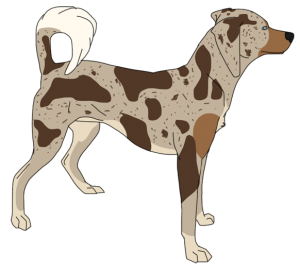Difference between revisions of "Laughing Boar Hound"
RedAttendant (talk | contribs) (Created page with "thumb The Laughing Boar Hound is a medium sized hound dog that is commonly used to hunt smaller game animals, though as its name suggests, its...") |
RedAttendant (talk | contribs) m |
||
| Line 31: | Line 31: | ||
[[Category:Common]] | [[Category:Common]] | ||
[[Category:Tameable]] | [[Category:Tameable]] | ||
| + | [[Category:Passive]] | ||
Latest revision as of 01:32, 26 April 2021
The Laughing Boar Hound is a medium sized hound dog that is commonly used to hunt smaller game animals, though as its name suggests, its main prey happens to be boar. They are stocky animals with a decent build that allows them to run at speeds, and move across long distances for a long period of time when at a more moderate pace. They are, on average, about 1.8 - 2.2 feet at the shoulder, and weigh in at around 50 - 90 pounds. They usually live to be around 10 - 14 years old.
They have a rather angular head with narrow snouts, and long, floppy ears. This allows them to gather scent as they track prey, and they have a very strong sense of smell. They can pick up on a scent that is up to three days old, and will track it for as long as they have it. Due to this habit, they have long tails with longer fur near the end, which act as a flag for hunters that are following the hounds through forests or tall grass; the dogs naturally carry their tails high, almost curling them over their backs.
They are very striking in color, as most dogs are tricolor, meaning they have three colors across their bodies, with the most common being black, tan, and white. They always have white chests, stomachs, and along the fur of the 'flags' on their tails, but the colored fur can range from a brown and red-brown color to grey and grey-blue color, though there are a number of combinations that can appear.
The most distinctive feature of this dog, however, is not a physical one, but rather the sound that they make. Rather than barking like most dogs, their calls can almost sound like rather sinister laughter--like that of a hyena--and it gets louder and more frantic the more excited the dog becomes. Longer calls are usually warnings, alerting other dogs or their masters that something is nearby, and a rapid series of calls signal that they have found the animal they have been tracking before they begin their pursuit. There are numerous other calls that these dogs make, as well as the usual whines and growls that other dogs make.
Distribution
They are found largely in broad climate, though neither thriving in very cold nor very hot places, kept by a variety of people. They are common in noble kennels for hunting parties, and are also kept by commoners for hunting, guarding, and as house pets. They generally do better in warmer climates.
Uses
These dogs have a variety of uses, but the most common is for hunting. They are often run in packs of up to ten dogs during a hunt, where they will all track a single animal, or a few animals while their masters follow either on foot, or on horseback. They are used to hunt deer, boar, wolves, and foxes, with boar being the most common prey they are set on.
They are also used as guard dogs, usually for livestock, though they will guard houses as well. While they are far from aggressive towards people, their calls are unsettling to people who are not used to hearing them, and even sometimes to those who have heard them, due to the fact that they sound nothing like what a dog would sound like.
These dogs are also sometimes kept as house pets, but these are usually older animals that are no longer able to work. Some dogs with more mellow temperaments are kept as pets all their lives, but it is much less common.
Relations
They are very friendly dogs, and are eager to please their masters. They are relatively easy to train, and have a natural prey drive that is easy to channel into hunting. They aren't attack dogs, and while they will call out a warning if someone unfamiliar approaches, they won't attack, and they rarely bite. They have some animal aggression, and they need to be trained to not attack and kill smaller animals, such as rabbits or foxes. If they aren't hunts can often end with smaller prey being ripped apart and rendered useless for the hunter. When they are trained, however, they will attack animals, but in a way that doesn't seriously harm them, and meant more to exhaust them.
| Geography • Races • Flora • Fauna • Stones • Metals • Cloth • Foreign Continents |
| The World of Aethius • The Multiverse of Aethier |
